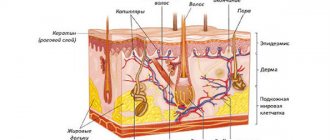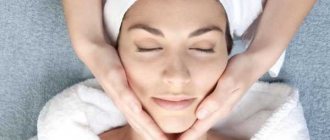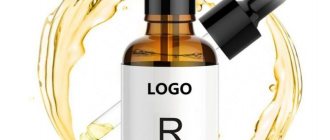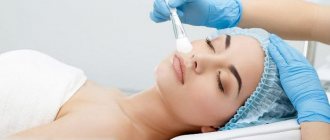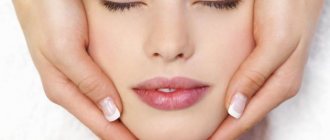The essence of the procedure
During peeling, a chemical composition is applied that removes the top layer of skin or affects deeper areas. Essentially this is a burn, but it helps to get rid of dead cells, excess fat, and traffic jams.
The procedure also causes a protective reaction in the tissues. Healthy cells of the collagen and elastin layers of the skin begin to actively divide, which leads to rejuvenation. The result is:
- increasing hydration and elasticity;
- disappearance of small wrinkles and smoothing of deep ones;
- lightening the surface, evening out the overall skin tone;
- elimination of scars and spots.
A person after chemical peeling needs rehabilitation, which varies in duration. The skin turns red, peels, and crusts may form on it. But when it is completely renewed, it becomes much better than before the procedure.
We recommend reading about ultrasonic peeling. You will learn about indications and contraindications, procedure techniques, the most common myths, as well as the cost of the procedure. And here is more information about what is better to choose: laser peeling or resurfacing.
Indications for use
Chemical peeling can be done from the age of 18. It will also help those over 25, and is also effective for older women. With the help of acid peeling, you can cope with many shortcomings:
- increased greasiness and clogged, enlarged pores;
- acne and the unevenness and spots left behind;
- weakened skin turgor;
- fine wrinkles and more pronounced facial folds;
- age spots;
- noticeable scars;
- bad complexion.
Cosmetic peeling: general concepts
Peeling is a universal cosmetic procedure that helps launch cell regeneration. During the process, the dead stratum corneum is exfoliated. Thanks to exfoliation (facial peeling), you can achieve a significant improvement in skin condition in a short time.
In most cases, girls who are dissatisfied with the appearance of their skin resort to the procedure. However, the procedure is often performed by older ladies who want to regain their former youth. It is known that with age, the processes of cell renewal and regeneration slow down, and less elastin and collagen are produced in the deep layers of the dermis. Facial peeling is exactly the procedure that activates metabolic processes. The result of cosmetic procedures is renewed, refreshed skin.
“After 25 years, the vast majority of girls experience their first skin problems. Small wrinkles appear in the corners of the eyes, age spots and other defects.”
Lyudmila Ivanova
Exfoliation allows you to get rid of many minor skin defects. After a course of facial peeling, the following defects disappear:
- acne and post-acne marks;
- expression wrinkles;
- scars and pigmentation.
The effect of cosmetic peeling can last up to a year, and there is no need to resort to the services of a plastic surgeon. This is one of the benefits of the procedure that has made it so widespread.
Contraindications
If a woman is planning to undergo a chemical facial peel, contraindications are the first thing she should know about. These include:
- dermatological diseases of inflammatory and other nature;
- intolerance to the components of the drug;
- pregnancy and breastfeeding;
- any infection, including skin infection;
- oncology;
- mental disorders, epilepsy;
- laser procedure or photorejuvenation performed less than six months earlier;
- pronounced rosacea.
For information about important points you should know before starting a chemical peel, watch this video:
Peeling after 50 years
At this age, the contours of the face are already lost, the line of the eyebrows drops. It is impossible to do without serious intervention.
Phenol facial peeling
This peeling is an anti-wrinkle treatment. The procedure is painful and requires anesthesia. However, after recovery, which takes about a week, the skin is completely renewed. There are also precautions for this peeling. It contains phenol, which is very dangerous in large quantities. When deciding to undergo such a procedure, you need to contact only a competent specialist. He will select the right amount of the drug and will not harm the patient’s health. The advantage of peeling is that the results last for several years.
Preparations for the procedure
Chemical peeling of the facial skin is carried out with acids. They affect the surface with different intensities:
- Products based on hydroxy acids. These are all fruity and glycolic, providing a gentle effect on the skin. They belong to the category of alpha hydroxy acids. Fruit and glycolic peelings help nourish the skin with moisture, so they are more suitable for extreme dryness. Beta-hydroxy acids also belong to this group.
These substances penetrate deeper into the skin, therefore they are able to regulate the functioning of the sebaceous glands, more energetically stimulate the rejuvenating processes in it, and cleanse it carefully but efficiently. The most commonly used drug is salicylic acid. Alpha and beta hydroxy acids are found in the preparations Jan Marini, MD Forte, Cosmedix, Agera RX, LA Peel.
- Products whose main component is trichloroacetic acid. It comes in different concentrations, so there are preparations for medium and deep peels. In the first case, 25 - 30% substance is used. For a deep effect, a concentration of 40% is required. This series includes the drugs “Skintech Peel”, “Compositum”, “Obagi Blue Peel”, “Cosmedix”.
- Products with retinoic acid. Designed for so-called yellow peeling. The preparations also contain ascorbic, phytic, azelaic acids, and vitamin C. In beauty salons they use Mediderma products.
- Products containing phenol (carbolic acid). They also come in different concentrations, so they are used for medium or deep effects. These are drugs “MC Peel”, “Green mask”, etc.
What it is?
The procedure for deep cleansing the face using various acids is called chemical peeling. The active ingredients penetrate the skin and exfoliate dead cells. Renewal occurs as a result of regeneration of the epidermis and stimulation of the production of collagen and elastane.
Characteristics and features
Peeling with acids is a chemical burn controlled by a cosmetologist. When it is carried out, it is exposed to substances that destroy not only the top layer of dead cells, but also the deep layers of the epidermis. The main features include :
- you can choose the depth and intensity of exfoliation;
- dead cells dissolve and do not come off as when using a scrub;
- the protective layer of the skin is not damaged;
- Certain types of acids act from the inside when they penetrate the skin.
The effect of the procedure is noticeable immediately and lasts for five to six months.
Age dependence
The cosmetic procedure can be used by girls over 18 years of age for medical reasons. Depending on the age group, the skin is cleansed with various types of peeling:
- At 20–25 years old, the first skin problems may appear: it becomes dull, dry and rough. In this case, a gentle superficial peeling is used using lactic acids - a concentration of up to 40%.
- From 25 to 30 years old, the first small wrinkles and age spots may appear. A superficial type of peeling is used using lactic and glycolic acids. The concentration of the active substance depends on the woman’s age - up to 70%.
- From 30 to 40 years, the dermis becomes less elastic, the number of wrinkles near the eyes increases, and a nasolabial fold appears. The skin becomes dry, as a result of decreased functioning of the sebaceous glands, and other problems appear. For rejuvenation, medium peeling based on lactic, salicylic and retinoic acids is used.
- At 40–50 years old, the skin thins, wrinkles become clearer and pigmentation increases. The tone of the epidermis is reduced, tissues may sag. To stimulate cell function, deep peeling with phenol is used.
Reference . The cosmetologist will select a specific type of peeling that is most suitable for the age and skin type with a certain concentration of the active substance.
Pros and cons: arguments for and against
Benefits of the procedure:
- gentle dissolution of dead skin cells;
- stimulation of collagen and elastane production;
- even out complexion;
- skin rejuvenation;
- fight against wrinkles and age spots;
- treatment of acne, acne;
- stimulation of blood circulation;
- smoothing scars and acne marks;
- correction of age-related changes;
- normalization of the sebaceous glands;
- increasing skin elasticity.
We recommend: 7 types of mechanical peeling that will help you properly care for your skin and get rid of acne scars
Disadvantages of peeling include:
- Painful sensations . After exposure to acids, a burn occurs on the skin, which causes discomfort during and after the procedure. If the pain threshold is high, it is recommended to perform peeling with the addition of an anesthetic substance.
- Duration of the recovery period . After a cosmetic procedure, restoration of the dermis occurs within 10–14 days, with deep peeling - up to two months.
- Hyperpigmentation . A possible complication after peeling is the appearance of a dark area on light skin.
- Hypopigmentation . The appearance of a light area after the procedure on dark skin.
- Elimination of exposure to ultraviolet rays . It is forbidden to be in the sun for several months without applying a protective cream.
- Exacerbation of herpes infection . After peeling, herpes rashes may appear.
- Peeling must be carried out in a course . To cleanse and rejuvenate the skin, one procedure is not enough. The effect will be noticeable during the course of treatment.
- Erythema . As a result of the procedure, skin inflammation may occur - redness of the entire face or individual areas. This defect can last for several months.
- Allergic reactions . After exposure to acids, the face becomes red, so it is not easy to recognize an allergy. If swelling lasts for a long time, you should consult a doctor.
After peeling, you must follow the cosmetologist's recommendations to avoid possible complications.
Preparation
An effective chemical peeling procedure for the face is impossible without a preliminary stage. Preparation begins 2 weeks before exposure and includes:
- use of skin care products with vitamin A;
- taking oral antiviral drugs if the patient often has herpes;
- carrying out superficial peeling 10 - 14 days before the middle peeling;
- Using sunscreen before going outside to prevent your skin from getting tanned.
Types of facial peeling according to exfoliation method
In addition to types based on depth of impact, all peels are divided into 3 categories:
- Chemical. A popular procedure that is performed using a solution based on chemical acids. As a rule, this type of exfoliation is done in a salon, under the supervision of a cosmetologist. The doctor determines the optimal exposure time, monitoring the condition of the skin during the process.
- Hardware or physical. During the session, the face is gently polished using laser radiation or ultrasound. Special devices eliminate scars, scars, pigmentation and wrinkles without visible damage or complications.
- Mechanical. The simplest type, which can be done at home using various cosmetics with abrasive particles.
Each type differs in its action and properties. It is necessary to choose the appropriate procedure based on skin type, age characteristics, contraindications and the desired effect.
Is anesthesia necessary?
During the procedure, different layers of the skin are injured. This can cause pain or at best discomfort. However, with superficial peeling the sensations are quite tolerable; it is only a slight burning sensation. Therefore, anesthesia is not needed.
Medium peeling is a more serious effect. During the procedure, the discomfort may be stronger, so an analgesic is taken before the procedure.
Deep peeling has an even stronger effect on the skin. It removes the entire top layer (epidermis) and affects the dermis. Therefore, the procedure is more like a surgical operation. It is performed by a plastic surgeon with the help of an anesthesiologist. And in this case general anesthesia is given. But some time ago, gentle formulations for deep effects appeared. With them, an injection of an anesthetic drug is sufficient.
Description
The main essence of any of the procedures is the effect of various chemical compounds on the skin, which not only remove post-inflammatory or age-related changes, but also significantly increase the protective properties of the skin. Depending on the technique, cleansing of the skin is achieved through a chemical burn with an effect on all layers of the epidermis or careful removal of only the top layer. Given the aggressiveness of chemical peeling, cosmetic surgery must be performed by a qualified specialist.
Technique
When talking about the specific features of chemical peels for the face, the types are the main thing that determines them. How each procedure goes:
- Deep peeling begins with anesthesia. If there is general anesthesia, the patient’s condition is also monitored using a cardiac machine. Then comes a thorough cleansing of the skin with detergent and a hard sponge. After rinsing the skin with water, blot it with a napkin and degrease it with alcohol. Then the drug with phenol is applied. For a more uniform distribution, the second stage is the application of a polymer composition - jelly.
The patient lives for a couple of days with a mask formed on her face. Then it is removed along with the top layer of skin and a drug with antibiotics is applied.
- Medium peeling is also preceded by facial cleansing , but with lotion. Next, it is dried and treated with an antiseptic. The main preparation is applied with a brush. It can also be rubbed into the skin for a more noticeable effect. There are from 1 to 4 layers of the product; they remain on the face for 5 - 20 minutes. All this time, discomfort from exposure is eliminated with a stream of cool air.
When a white film forms on the surface, the drug is removed using an alkaline composition. Then the skin is treated with a disinfectant and emollient.
- Light chemical peeling of the face (superficial) begins with the application of a cleansing foam , which remains for a couple of minutes. Then it is washed off and the main product is applied to dry skin. When it is absorbed, you can apply a second layer. After 10 minutes, the composition is removed with a damp cloth or neutralizer. Dried skin is treated with tonic and moisturized with a special product.
Reviews
I have had acne scars since I was a teenager. It was impossible to remove it with banal means, so I went to a cosmetologist. Just 1 procedure (medium peeling, it was painful, I looked at myself in the mirror with horror for a week and constantly applied cream to my skin), and after a week, when the redness went away and the crusts fell off, I discovered that the skin was pink, and the acne marks were barely noticeable! I think that we need to continue the course, as the cosmetologist advised.
I listened enough to my friends and went for peeling. I thought it would be the same as in the stories: they anointed my face and after a couple of days my skin was as good as new – clean and pink, like a baby’s. The reality turned out to be worse - painful, expensive and ineffective. After 2 procedures, practically nothing has changed on my face. No, the skin became softer and lighter, but that’s all. But I would like the red spots, unevenness and small pits after acne to disappear.
Skin care after
The skin remains traumatized as a result of peeling, so on the day of the procedure you should not touch it, you should not even wash your face. The face may look swollen and red. Then a film forms on the skin and it begins to peel off.
Care includes:
- Washing with mild products 24 hours after superficial exposure, 2 - 4 days after medium exposure. Deep peeling requires treating the face with antiseptics until a dry film and crusts form on the skin.
- Apply Bepanten or Panthenol spray to the flaky face. This can be done a day after a light peel, 2 - 4 after a medium peel. At the same time, the spray is applied to the deeply exposed face. Use the product several times a day for 15 - 20 minutes, then blot the skin with a napkin.
- When the dry film and crusts come off, you can use regular moisturizing cosmetics. And before going outside, you should apply sunscreen.
- Other caring procedures, sunbathing, baths, swimming, sports and decorative cosmetics should be avoided for now. You should also not peel off dry scales, films and crusts. They should fall off on their own.
How often a chemical facial peel is performed depends on the condition of the skin and the type of treatment. With proper care, she will be ready for the next superficial or mid-level procedure in 7 to 14 days. The course consists of 4 - 10 sessions. Light peeling can be done every 4 - 6 months. It is enough to carry out the average impact 1 - 2 times a year. Deep peeling is a once-in-a-lifetime treatment.
Chemical peeling at home
At home, it is permissible to carry out only superficial peeling; the use of concentrated preparations for mid-grade rejuvenation is possible strictly in a cosmetology center.
Superficial chemical peeling does not require special skin preparation. The procedure consists of several stages:
- Cleansing the skin of decorative cosmetics.
- Apply the product in one layer to the skin in the sequence forehead-chin-cheeks-nose.
- Removal of the composition after the time specified in the instructions.
- Applying a moisturizing mask.
- Applying moisturizer.
A number of products for superficial peeling at home can be applied at night - the concentration of acids in these preparations is relatively low, so even prolonged contact with the skin will not lead to chemical burns. There are also spot action products - applications should be made with tampons treated with the working composition, applying them to problem areas of the face for a specified period of time.
Possible complications
In the worst case, manipulation can lead to new problems:
- dermatitis of various nature;
- persistent erythema;
- hyperpigmentation or marbled skin effect;
- scars;
- exacerbation of herpes or acne;
- rosacea;
- burn;
- the effect of a mask on the face.
Complications after peeling
Most of them occur when rehabilitation requirements are ignored. Sometimes the cause of complications is the incorrect actions of the doctor.


